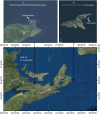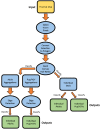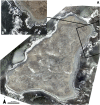Automated detection and enumeration of marine wildlife using unmanned aircraft systems (UAS) and thermal imagery
- PMID: 28338047
- PMCID: PMC5364474
- DOI: 10.1038/srep45127
Automated detection and enumeration of marine wildlife using unmanned aircraft systems (UAS) and thermal imagery
Abstract
Estimating animal populations is critical for wildlife management. Aerial surveys are used for generating population estimates, but can be hampered by cost, logistical complexity, and human risk. Additionally, human counts of organisms in aerial imagery can be tedious and subjective. Automated approaches show promise, but can be constrained by long setup times and difficulty discriminating animals in aggregations. We combine unmanned aircraft systems (UAS), thermal imagery and computer vision to improve traditional wildlife survey methods. During spring 2015, we flew fixed-wing UAS equipped with thermal sensors, imaging two grey seal (Halichoerus grypus) breeding colonies in eastern Canada. Human analysts counted and classified individual seals in imagery manually. Concurrently, an automated classification and detection algorithm discriminated seals based upon temperature, size, and shape of thermal signatures. Automated counts were within 95-98% of human estimates; at Saddle Island, the model estimated 894 seals compared to analyst counts of 913, and at Hay Island estimated 2188 seals compared to analysts' 2311. The algorithm improves upon shortcomings of computer vision by effectively recognizing seals in aggregations while keeping model setup time minimal. Our study illustrates how UAS, thermal imagery, and automated detection can be combined to efficiently collect population data critical to wildlife management.
Conflict of interest statement
The authors declare no competing financial interests.
Figures





Similar articles
-
Assessing the disturbance potential of small unoccupied aircraft systems (UAS) on gray seals (Halichoerus grypus) at breeding colonies in Nova Scotia, Canada.PeerJ. 2018 Mar 19;6:e4467. doi: 10.7717/peerj.4467. eCollection 2018. PeerJ. 2018. PMID: 29576950 Free PMC article.
-
Remote sensing techniques for automated marine mammals detection: a review of methods and current challenges.PeerJ. 2022 Jun 20;10:e13540. doi: 10.7717/peerj.13540. eCollection 2022. PeerJ. 2022. PMID: 35757165 Free PMC article. Review.
-
Unoccupied Aircraft Systems in Marine Science and Conservation.Ann Rev Mar Sci. 2019 Jan 3;11:439-463. doi: 10.1146/annurev-marine-010318-095323. Epub 2018 Jul 18. Ann Rev Mar Sci. 2019. PMID: 30020850 Review.
-
Google Haul Out: Earth Observation Imagery and Digital Aerial Surveys in Coastal Wildlife Management and Abundance Estimation.Bioscience. 2017 Aug 1;67(8):760-768. doi: 10.1093/biosci/bix059. Epub 2017 Jun 14. Bioscience. 2017. PMID: 29599542 Free PMC article.
-
Integrating satellite and unmanned aircraft system (UAS) imagery to model livestock population dynamics in the Longbao Wetland National Nature Reserve, China.Sci Total Environ. 2020 Dec 1;746:140327. doi: 10.1016/j.scitotenv.2020.140327. Epub 2020 Jun 20. Sci Total Environ. 2020. PMID: 32768776
Cited by
-
New technologies in the mix: Assessing N-mixture models for abundance estimation using automated detection data from drone surveys.Ecol Evol. 2020 Jun 30;10(15):8176-8185. doi: 10.1002/ece3.6522. eCollection 2020 Aug. Ecol Evol. 2020. PMID: 32788970 Free PMC article.
-
Accurate Non-Disturbance Population Survey Method of Nesting Colonies in the Reedbed with Georeferenced Aerial Imagery.Sensors (Basel). 2020 May 2;20(9):2601. doi: 10.3390/s20092601. Sensors (Basel). 2020. PMID: 32370283 Free PMC article.
-
Remotely Piloted Aircraft System (RPAS)-Based Wildlife Detection: A Review and Case Studies in Maritime Antarctica.Animals (Basel). 2020 Dec 14;10(12):2387. doi: 10.3390/ani10122387. Animals (Basel). 2020. PMID: 33327472 Free PMC article. Review.
-
Artificial intelligence for automated detection of large mammals creates path to upscale drone surveys.Sci Rep. 2023 Jan 18;13(1):947. doi: 10.1038/s41598-023-28240-9. Sci Rep. 2023. PMID: 36653478 Free PMC article.
-
Evaluating Thermal Infrared Drone Flight Parameters on Spider Monkey Detection in Tropical Forests.Sensors (Basel). 2024 Aug 30;24(17):5659. doi: 10.3390/s24175659. Sensors (Basel). 2024. PMID: 39275572 Free PMC article.
References
-
- Krebs C. J., Hickman G. C. & Hickman S. M. Ecology: The Experimental Analysis of Distribution and Abundance. Blackwell Science Inc, New York (1994).
-
- Lancia R. A., Kendall W. L., Pollock K. H. & Nichols J. D. Estimating the number of animals in wildlife populations. In Braun C. E. (ed) Techniques for Wildlife Investigations and Management. Wildlife Society, Bethesda, Maryland, 106–153 (2005).
-
- Buckland S. T., Anderson D. R., Burnham K. P. & Laake J. L. Distance Sampling. In Encyclopedia of Biostatistics. John Wiley & Sons Ltd, Chichester, UK (2005).
-
- Bonner S. J. & Holmberg J. Mark-recapture with multiple, non-invasive marks. Biometrics 69, 766–775 (2013). - PubMed
Publication types
MeSH terms
LinkOut - more resources
Full Text Sources
Other Literature Sources

